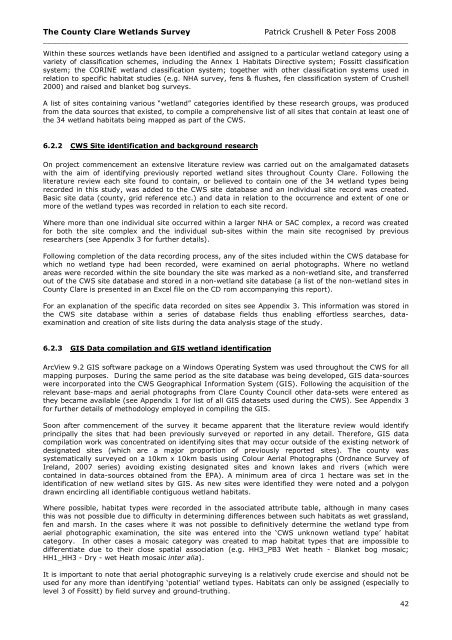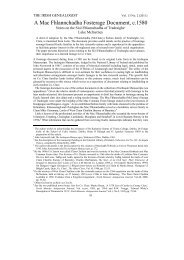Report Cover Vol I - Clare County Library
Report Cover Vol I - Clare County Library
Report Cover Vol I - Clare County Library
Create successful ePaper yourself
Turn your PDF publications into a flip-book with our unique Google optimized e-Paper software.
The <strong>County</strong> <strong>Clare</strong> Wetlands Survey Patrick Crushell & Peter Foss 2008<br />
____________________________________________________________________________________<br />
Within these sources wetlands have been identified and assigned to a particular wetland category using a<br />
variety of classification schemes, including the Annex 1 Habitats Directive system; Fossitt classification<br />
system; the CORINE wetland classification system; together with other classification systems used in<br />
relation to specific habitat studies (e.g. NHA survey, fens & flushes, fen classification system of Crushell<br />
2000) and raised and blanket bog surveys.<br />
A list of sites containing various “wetland” categories identified by these research groups, was produced<br />
from the data sources that existed, to compile a comprehensive list of all sites that contain at least one of<br />
the 34 wetland habitats being mapped as part of the CWS.<br />
6.2.2 CWS Site identification and background research<br />
On project commencement an extensive literature review was carried out on the amalgamated datasets<br />
with the aim of identifying previously reported wetland sites throughout <strong>County</strong> <strong>Clare</strong>. Following the<br />
literature review each site found to contain, or believed to contain one of the 34 wetland types being<br />
recorded in this study, was added to the CWS site database and an individual site record was created.<br />
Basic site data (county, grid reference etc.) and data in relation to the occurrence and extent of one or<br />
more of the wetland types was recorded in relation to each site record.<br />
Where more than one individual site occurred within a larger NHA or SAC complex, a record was created<br />
for both the site complex and the individual sub-sites within the main site recognised by previous<br />
researchers (see Appendix 3 for further details).<br />
Following completion of the data recording process, any of the sites included within the CWS database for<br />
which no wetland type had been recorded, were examined on aerial photographs. Where no wetland<br />
areas were recorded within the site boundary the site was marked as a non-wetland site, and transferred<br />
out of the CWS site database and stored in a non-wetland site database (a list of the non-wetland sites in<br />
<strong>County</strong> <strong>Clare</strong> is presented in an Excel file on the CD rom accompanying this report).<br />
For an explanation of the specific data recorded on sites see Appendix 3. This information was stored in<br />
the CWS site database within a series of database fields thus enabling effortless searches, dataexamination<br />
and creation of site lists during the data analysis stage of the study.<br />
6.2.3 GIS Data compilation and GIS wetland identification<br />
ArcView 9.2 GIS software package on a Windows Operating System was used throughout the CWS for all<br />
mapping purposes. During the same period as the site database was being developed, GIS data-sources<br />
were incorporated into the CWS Geographical Information System (GIS). Following the acquisition of the<br />
relevant base-maps and aerial photographs from <strong>Clare</strong> <strong>County</strong> Council other data-sets were entered as<br />
they became available (see Appendix 1 for list of all GIS datasets used during the CWS). See Appendix 3<br />
for further details of methodology employed in compiling the GIS.<br />
Soon after commencement of the survey it became apparent that the literature review would identify<br />
principally the sites that had been previously surveyed or reported in any detail. Therefore, GIS data<br />
compilation work was concentrated on identifying sites that may occur outside of the existing network of<br />
designated sites (which are a major proportion of previously reported sites). The county was<br />
systematically surveyed on a 10km x 10km basis using Colour Aerial Photographs (Ordnance Survey of<br />
Ireland, 2007 series) avoiding existing designated sites and known lakes and rivers (which were<br />
contained in data-sources obtained from the EPA). A minimum area of circa 1 hectare was set in the<br />
identification of new wetland sites by GIS. As new sites were identified they were noted and a polygon<br />
drawn encircling all identifiable contiguous wetland habitats.<br />
Where possible, habitat types were recorded in the associated attribute table, although in many cases<br />
this was not possible due to difficulty in determining differences between such habitats as wet grassland,<br />
fen and marsh. In the cases where it was not possible to definitively determine the wetland type from<br />
aerial photographic examination, the site was entered into the ‘CWS unknown wetland type’ habitat<br />
category. In other cases a mosaic category was created to map habitat types that are impossible to<br />
differentiate due to their close spatial association (e.g. HH3_PB3 Wet heath - Blanket bog mosaic;<br />
HH1_HH3 - Dry - wet Heath mosaic inter alia).<br />
It is important to note that aerial photographic surveying is a relatively crude exercise and should not be<br />
used for any more than identifying ‘potential’ wetland types. Habitats can only be assigned (especially to<br />
level 3 of Fossitt) by field survey and ground-truthing.<br />
42
















